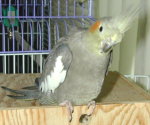 |
BREEDS
& THEIR NEEDS
Cockatiels
 
|
 |
|
Lutino
Cockatiels |
Normal
Cockatiel Cockbird |
 |
 |
 |
 |
 |
White-faced
Pied cock,
Silver Cock + Cinnamon Pearl Hen |
Lutino
Hen, Cinnamon Hen + Platinum Cock |
Assorted
colours |
Normal
cockatiel
The Male has brighter colours |
Normal
cockatiel Hen - note duller colouration |
- The normal colour for Cockatiels is dark grey
with orange cheeks.
SEXING
- It's very difficult to sex cockatiels until
they go thru their first juvenile moult,
around 6 months
- as until then they all
look like hens.
- A similar trait is found in a lot of
other birds (i.e. Barrabands)
- However, as in a lot of breeds of birds - hens
bite and I mean bite, if they get hold of a finger they feels as if they are
going into the bone. They need this natural defence mechanism to
defend their nests and young.
SEXING AFTER FIRST JUVENILE MOULT
- The cock birds are, by nature, much gentler.
- The cock birds' colours are brighter but the
hen stays duller, esp. round the head area.
- Hens have horizontal barring down the under
side of the tail feathers, which is visible even in the Lutino
variety. This is missing in the cockbird.
- The Pearl variety is slightly easier to sex, as
the cockbird loses it's "Pearl" markings after the
first moult and the hen retains them. So, once they have
moulted if you have a Pearl marked bird
it will be a Hen.
- The cockbird starts to warble, whistle and
strut - usually towards the time or just after the
first moult.
- In a Pet-bird environment it is
often a good "talker" and whistler (mainly the cockbird)
- it will also copy the phone and similar noises.
- They make good pets, however the hens do tend
to have quite a sharp, piercing call, that isn't
too bad unless you keep a mimicking
parrot, such as an African Grey in the same house and then
the sound the A.
Grey makes mimicking the cockatiel is quite ear piercing - not good on the
ears !
COLOURS
- There are many mutation colours nowadays,
including Lutino, Albino, Cinnamon, Pearls and Pieds.
- Including many
variations within the White-faced variety i.e. silver, platinum,
white-faced pied etc. (These
variations lose the orange cheeks which are replaced by white).
- The Lutino (red-eye) variety are often
predisposed to having a hereditary bald area on the top of
their heads
behind their crest.
DIET
- As they originate from the arid areas of
Australia they survive well on small parakeet mix and
don't tend to partake
much of fruit and veg. with quite the same enthusiasm as some breeds.
- They do enjoy raw carrots, apple and chickweed
etc.
- They love millet sprays.
- As per most birds they love cooked Frozen
Sweetcorn, (TO COOK: put into container,
fill to its
own level with boiling water and put in microwave for 2 -
3mins). Drain off the water before
mixing with EMP Egg food. (you can
add any supplements necessary to this mix).
- This is a good feed to offer when breeding and
feeding chicks as are millet sprays.
- They also like wholemeal bread.
BREEDING
- They like a deep nestbox approx 8 - 9"
square and 14 - 16" deep with a pop-hole just slightly
wider than the
bird itself, so that it's a snug fit (see Notes on Nestboxes ).
- Use Easibed
or similar non-dusty wood chip for the base.
- They start breeding around March in England,
depending on the weather.
- You don't want them going down too early if the
weather is very cold, as you could end up with
Egg-binding or other
problems.
- They will breed en-colony but try and make sure
you have equal No. of cocks to hens otherwise
there will be squabbling.
- They do tend to mate "for life" and
will stay with the same partner year after year, so it's quite
cruel to
split them up, esp. if you keep them within calling distance of each other.
- Also, if you are breeding en-colony make sure
you have MORE Nest boxes than pairs
(experts
do say you should have twice as many nest boxes as pairs of birds but in my
experience,
so long as you have a few extra and they are all of similar
design and at the same height in the
Aviary, you don't have too many
problems).
- INCUBATION: 18 - 20 days,
depending on when they start to sit.
- They lay 4 - 6 eggs
on alternate days.
- FLEDGE
around 34-36 days
- Eyes fully opened
around 12 days
- RING: around 12 - 14 days -
- RING SIZE:
P (same as G.Cheek Conures)
- The chicks hatch covered with a fine
down.
- Usually white if they are a "red-eyed"
or white-face variety
- pale grey if they are an orange-cheeked variety.
- "Silvers" can be recognised in
the nest becos they have a "Skull cap" as they start to
feather-up.
^ Top |